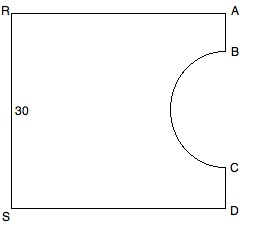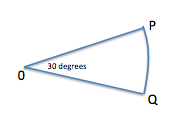All SAT Math Resources
Example Questions
Example Question #1 : How To Find The Angle Of Clock Hands
What is the measure, in degrees, of the acute angle formed by the hands of a 12-hour clock that reads exactly 3:10?
60°
72°
65°
35°
55°
35°
The entire clock measures 360°. As the clock is divided into 12 sections, the distance between each number is equivalent to 30° (360/12). The distance between the 2 and the 3 on the clock is 30°. One has to account, however, for the 10 minutes that have passed. 10 minutes is 1/6 of an hour so the hour hand has also moved 1/6 of the distance between the 3 and the 4, which adds 5° (1/6 of 30°). The total measure of the angle, therefore, is 35°.
Example Question #1 : How To Find The Angle Of Clock Hands
If it is 4:00, what is the measure of the angle between the minute and hour hands of the clock?
125 degrees
100 degrees
90 degrees
120 degrees
45 degrees
120 degrees
A clock takes the shape of a circle, which is composed of 360 degrees. There are 12 numbers on a clock that represent the hours. With this in mind, we can say that each number represents an angle. The measure of the angle between each number is given by 
If it is 4:00, then the minute hand is pointing towards 12 while the hour hand points towards 4.
Therefore, we can say that the angle between the two hands is 
Another way to think of this is to imagine the clock at a nearby time. At 3:00, the hands of the clock form a right angle of 90 degrees. Since we know that each number on the clock is separated by 30 degrees, we can simply add 30 to 90 degrees and get 120 degrees for the angle at 4:00.
Example Question #2 : How To Find The Angle Of Clock Hands
If it is 2:00 PM, what is the measure of the angle between the minute and hour hands of the clock?
90 degrees
120 degrees
45 degrees
60 degrees
30 degrees
60 degrees
First note that a clock is a circle made of 360 degrees, and that each number represents an angle and the separation between them is 360/12 = 30. And at 2:00, the minute hand is on the 12 and the hour hand is on the 2. The correct answer is 2 * 30 = 60 degrees.
Example Question #1 : How To Find The Percentage Of A Sector From An Angle
Two pizzas are made to the same dimensions. The only difference is that Pizza 1 is cut into pieces at 30° angles and Pizza 2 is cut at 45° angles. They are sold by the piece, the first for $1.95 per slice and the second for $2.25 per slice. What is the difference in total revenue between Pizza 2 and Pizza 1?
–$5.40
–$2.70
$2.70
$5.40
$0
–$5.40
First, let's calculate how many slices there are per pizza. This is done by dividing 360° by the respective slice degrees:
Pizza 1: 360/30 = 12 slices
Pizza 2: 360/45 = 8 slices
Now, the total amount made per pizza is calculated by multiplying the number of slices by the respective cost per slice:
Pizza 1: 12 * 1.95 = $23.40
Pizza 2: 8 * 2.25 = $18.00
The difference between Pizza 2 and Pizza 1 is thus represented by: 18 – 23.40 = –$5.40
Example Question #1 : Plane Geometry
A circular, 8-slice pizza is placed in a square box that has dimensions four inches larger than the diameter of the pizza. If the box covers a surface area of 256 in2, what is the surface area of one piece of pizza?
36π in2
18π in2
9π in2
144π in2
4.5π in2
4.5π in2
The first thing to do is calculate the dimensions of the pizza box. Based on our data, we know 256 = s2. Solving for s (by taking the square root of both sides), we get 16 = s (or s = 16).
Now, we know that the diameter of the pizza is four inches less than 16 inches. That is, it is 12 inches. Be careful! The area of the circle is given in terms of radius, which is half the diameter, or 6 inches. Therefore, the area of the pizza is π * 62 = 36π in2. If the pizza is 8-slices, one slice is equal to 1/8 of the total pizza or (36π)/8 = 4.5π in2.
Example Question #2 : Plane Geometry

If B is a circle with line AC = 12 and line BC = 16, then what is the area formed by DBE?
Line AB is a radius of Circle B, which can be found using the Pythagorean Theorem:
Since AB is a radius of B, we can find the area of circle B via:
Angle DBE is a right angle, and therefore 

Example Question #3 : Plane Geometry

The radius of the circle above is 

Area of Circle = πr2 = π42 = 16π
Total degrees in a circle = 360
Therefore 45 degree slice = 45/360 fraction of circle = 1/8
Shaded Area = 1/8 * Total Area = 1/8 * 16π = 2π
Example Question #321 : Psat Mathematics


The arc from 


All units are in feet.
The diagram shows a plot of land.
The cost of summer upkeep is $2.50 per square foot.
In dollars, what is the total upkeep cost for the summer?
To solve this, we must begin by finding the area of the diagram, which is the area of the square less the area of the semicircle.
The area of the square is straightforward:
30 * 30 = 900 square feet
Because each side is 30 feet long, AB + BC + CD = 30.
We can substitute BC for AB and CD since all three lengths are the same:
BC + BC + BC = 30
3BC = 30
BC = 10
Therefore the diameter of the semicircle is 10 feet, so the radius is 5 feet.
The area of the semi-circle is half the area of a circle with radius 5. The area of the full circle is 52π = 25π, so the area of the semi-circle is half of that, or 12.5π.
The total area of the plot is the square less the semicircle: 900 - 12.5π square feet
The cost of upkeep is therefore 2.5 * (900 – 12.5π) = $(2250 – 31.25π).
Example Question #2 : Circles
In the figure, PQ is the arc of a circle with center O. If the area of the sector is 
First, we figure out what fraction of the circle is contained in sector OPQ: 

Using the formula for the area of a circle, 

We can use this to solve for the circumference of the circle, 

Now, OP and OQ are both equal to r, and PQ is equal to 

To get the perimeter, we add OP + OQ + PQ, which give us 
Example Question #261 : Sat Mathematics
A central angle of a circle measures 60 degrees. If its corresponding arc measures 3 units, what is the area of the circle?
If the central angle measures 60 degrees, divide the 360 total degrees in the circle by 60.
Multiply this by the measure of the corresponding arc to find the total circumference of the circle.
Use the circumference to find the radius, then use the radius to find the area.
All SAT Math Resources











































